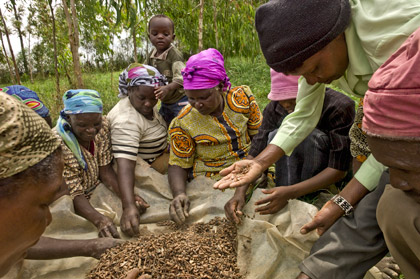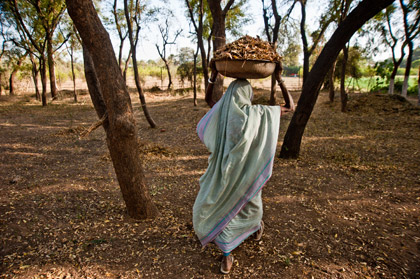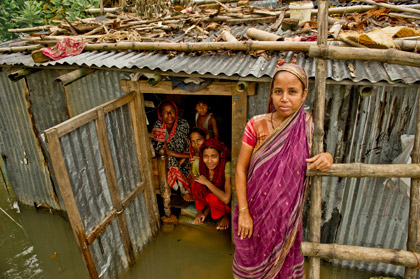Women, War and Natural Resources
Environmental conservationist and human rights activist Wangari Maathai, PhD, was awarded the Nobel Peace Prize in 2004 for her efforts to teach women in Kenya to plant trees. Together, she and the women of Kenya planted tens of millions of trees. As the Nobel Prize Committee noted, “Peace on Earth depends on our ability to secure our living environment,” many people scratched their heads at this notion since planting trees does not seem to be a salve for wars. However, Maathai understood this disconnect and upon receiving her award, she challenged people “to think holistically. Think of many conflicts – conflicts within your area, far away from your area and far away from your country – and ask yourself: Why are those people fighting? Almost every war is over access and control of resources.”
The data supports Maathai’s assertion as the nature of war has evolved. Today conflicts are more commonly fought within national borders rather than between states, and most of these occur in developing countries. During 2011, 27 armed conflicts occurred in the world, 26 of which were intrastate conflicts, and all but one occurred in developing countries. Not only has the geography of war changed but also the reasons wars are fought. Throughout the past 60 years it has been estimated that exploitation of natural resources has fueled more than 40 percent of the world’s violent conflicts. In the past 20 years alone, approximately 18 wars have resulted from natural resource disagreements.
University of California researchers note, “Civil wars, such as those in Liberia, Angola and Democratic Republic of Congo, have centered on ‘high-value’ resources like timber, diamonds, gold, minerals and oil. Other conflicts, including those in Darfur and the Middle East, have involved control of scarce resources, such as fertile land and water.” Natural resource-based conflicts are expected to increase dramatically in the face of growing water shortages, collapse of natural resource-based economies and security threats stemming from climate change. The changing nature of war has translated into a differential impact of war, which includes a largely overlooked group of people – women.
Natural resource exploitation is implicated in all phases of the conflict cycle, including contributing to the outbreak and perpetuation of violence as well as undermining prospects for peace. An analysis of intrastate fighting in the past 60 years indicates that wars associated with natural resources are twice as likely to relapse in the first five years post-conflict. Despite these facts, less than 25 percent of peace negotiations have focused on addressing natural resource management mechanisms in post-conflict discussions. Integrating environment and natural resources into peace building is an unmet security imperative thus far.
While degradation and loss of natural resources is the basis for conflict in many countries – and detrimental to societies as a whole – women are often disproportionally impacted by both diminished natural resource bases and resulting conflicts. Around the world, rural women provide most of the food, water and health security for their families. Rural women in developing countries suffer extreme inequality in welfare, specifically in regards to health, life expectancy at birth, quality of life, workload, education, legal rights and economic mobility.

© Lynn Johnson/Ripple Effect Images
Women and girls in developing countries are often isolated from economic opportunities, have less access to basic social services and, therefore, rely heavily on goods and services derived from natural resources to meet their daily needs. As a result, disruption of natural services has serious implications for the peace, security and safety of women and girls as well as for their health and economic well-being.
Resource degradation is an acute problem in rural areas with more than 60 percent of the world’s poorest people living in ecologically vulnerable areas. For example, more than 60 percent of women in South Africa rely directly on natural resources for their survival needs and for those of their families. And in Mozambique this number climbs to 70 percent. In addition to basic sustenance, use of natural resources is often a large proportion of the livelihood needs for women in rural communities. For instance, women in Sub-Saharan Africa derive 30 to 50 percent of their non-farm income from natural resources, and in South Africa this number increases to 80 percent or more. As natural resources degrade, women’s already very limited economic opportunities are jeopardized. Poverty rates climb and women are trapped in a vicious cycle. Their inability to generate revenue contributes further to greater resource loss and increased inequality, thus providing the groundwork for regional instability and conflict.
The international community has made significant strides to address women’s special needs and skills in issues surrounding conflict and conflict resolution. Much of this effort stems from the United Nation’s Security Council Resolution 1325 (UNSCR1325), passed in 2000, which recognizes the particular effect conflict has on women and the need to include them as active stakeholders in conflict prevention and resolution. UNSCR1325 also ensures that peacekeepers, police and judiciary members are trained to ensure the human rights of women and girls. Finally, the resolution helps guarantee that women who have been impacted by armed conflict are represented in peace talks and included at all levels of decision-making.
While UNSCR1325 increases women’s roles as military observers, civilian police, humanitarian and human rights observers, it fails to support – or even address – their equally important inclusion in environmental decision-making. As a result, advances in incorporating gender perspectives into peace keeping and conflict prevention are often undermined by failure to address the critical link between women and natural resources management. Although women’s rights and gender equality in post conflict settings consider many relevant issues; such as HIV/AIDS, human rights violations and gender based violence; natural resources – the basis for survival for the majority of the world’s poor – remain omitted from most peace and security agendas.
As the government of Finland notes: “Most of the work on Resolution 1325 concentrates on only a very few sectors, such as promotion of women in politics and governance, legislation, etc. There is very little support for creating new partnerships between, for example, women’s organizations and groups of officials, civil servants or CSOs (Civil Society Organizations) in other sectors, such as natural resource management or the environment. More support is needed for facilitation of women’s participation in the implementation of Resolution 1325, particularly for women as civil servants, as well as for the creation of networks between women’s NGOs (Non-Governmental Organizations) and organizations operating in related fields.”
Women’s Role in Preventing Conflict
When international organizations and actors from different countries discuss conflict prevention with regards to women, they often refer to prevention of sexual violence rather than prevention of the core conflict. When people talk about preventing conflict, they need to address the root causes of conflict, which often stem from basic needs like land disputes, the impact of displaced people, the absence of food, energy and water security or severe inequalities in social structures.

© Annie Griffiths/Ripple Effect Images
Women are often the practical, but unrecognized, managers of many natural resources at the community level. They choose where to harvest wood used for cooking and for providing warmth and light; they establish which watering holes are to be used to clean dishes, to wash children and to water animals, and they determine what crops get planted to feed their families. Despite these roles as resource managers, women are rarely included in natural resource management strategies. For example, women in Sub-Saharan Africa provide more than 80 percent of the food security but receive only 5 percent of the agricultural tools and credit extended to farmers. As a result, women’s farmland frequently collapses and further increases deforestation. Providing women with the skills to effectively manage their natural resources is a critical step in stabilizing resource use and preventing conflict.
Improving women’s economic status is also critical to conflict prevention and mitigation. Since economic development is dependent on access to and ownership of natural resources, it is necessary to recognize that conflict prevention depends both on an achievement of substantive gender equality and a commitment to non-violence. This requires addressing issues related to peace and security with a broader set of actors, which includes the environmental sector, than is currently conceived in formulation of national action plans developed in support of UNSCR 1325. For example, natural resource smuggling can destabilize a society and is often used to fund war. This illegal activity can deprive women of resources required to perform daily chores, which is particularly problematic when those women are key economic actors. In such circumstances, an individual or group’s potential development is held back by uneven distribution of power and resources.
Impacts During Conflict
Economic strategies during armed conflict are often determined by ability to first meet basic survival needs. In order to accomplish these at the household level, women are often forced to change the way they use natural resources, frequently switching to less sustainable practices. This makes sense since short-term decision making trumps long-term planning during times of war. As a result, farmlands become less productive due to inefficient agriculture practices, and people must draw down existing food supplies, which often causes famine. Under such severe circumstances, natural resource-driven survival strategies can cause shifts in social structures to the further detriment of women. For example, in Mozambique’s 15-year civil war, burning of forests and overexploitation of natural resources were both direct and indirect consequences of the war and drought.
In that circumstance, travelling to collect water and fuel wood became increasingly dangerous for women and girls, which led to overuse of local sources. Trees and other vegetation were also in increased demand as building materials for temporary accommodation of displaced persons. As a result, soil quality deceased while intensity cultivation increased on lands close to secure areas or accommodation centers. In addition, fish stocks were overexploited as people moved towards safer coastal areas and rivers and because alternative protein sources were lacking. Finally, some people made considerable gains at the expense of most community members from illegal wildlife smuggling.
One of the biggest challenges related to natural resources and the conflict arena pertains to internationally displaced persons (IDPs), the majority of whom are women and children. In addition to exposure to gender-based violence, IDPs suffer increased poverty and violation of their property rights.

© Ami Vitale/Ripple Effect Images
Importantly, a clear correlation exists between women’s poverty levels, economic dependency and the levels of sexual gender-based violence (SGBV). In such instances, the tendency is to take away any and all resources from women, particularly resources traditionally “controlled,” managed or worked on by women. This often impacts natural resource use, including changes to agricultural land, forest management and water systems. Furthermore, as resources collapse the opportunities for economic advancement are diminished. Finally, without land tenure or other property rights, it is difficult for women to make effective long-term resource decisions thereby ensuring an ongoing cycle of violence, poverty and natural resource degradation.
Post-Conflict Considerations
Tremendous opportunities exist to secure policies for lasting change for women post-conflict, particularly with regard to their ability to access and to effectively use natural resources. For example, after the genocide Rwanda used the post-conflict arena to strengthen both its engagement of women in democracy as well as in natural resource conservation. Conversely, failure to address links between women and natural resources can have devastating implications for women and girls.
In Kenya one of the biggest challenges for displaced women, in addition to exposure to sexual violence, has been violation of their property rights. Once displaced or widowed, women were often unable to take ownership of family property upon return to their homes. Land is often held in the husband’s name, and women are not regarded as having the capacity to own the property. This exposes women to harassment; it increases inequality, and it prevents women from securing the resources needed for survival for themselves and their families. It also leads to continued environmental degradation as women are unable or unwilling to make long-term investments in their land, which might include things like planting long-lived trees to provide shade and to protect soils or improving farming practices in lieu of cutting down old growth forests to expand gardens to increase crop yields.
During conflict many women take over jobs previously held by men as they leave to participate in combat. Women acquire the necessary skills to perform economic-based activities, particularly in the agriculture sector. However, women frequently get displaced from these positions once men are demobilized. For example, in Nicaragua approximately 16,000 women lost their jobs when male combatants returned from battle. Programs centered on post-conflict economic redevelopment and employment generation that do not consider women not only miss out on the opportunity to capitalize on women as a component of the formal workforce but also risk marginalizing women and reinforcing gender inequalities with subsequent increases in poverty and disease. Providing women opportunities to continue to earn an income after fighting has ceased can be beneficial for increasing both household incomes and national economies. This inherently requires more equitable access to resources associated with common post-conflict livelihoods and economies, such as land, crops, water, energy and timber.
Shifting demographics after conflict can also lead to shifting roles and responsibilities for women. After men depart from communities to serve as combatants, many women attain greater control over community organization and decision-making. This can mean greater control over natural resource management as women are left in charge of water and agriculture resources used for livelihoods and other community needs. As men return home throughout the post-conflict period, gender roles undergo further changes that differ from community to community. For peacekeeping and peace building efforts to be successful these changing dynamics must be considered.
In summary, for successful implementation of peacekeeping efforts, such as applying UN Security Council Resolution 1325, stakeholders must recognize the link between women, war and natural resources. Securing participation of women in natural resource management efforts at all levels of governance, planning and funding decisions will strengthen peace and security efforts. Furthermore, securing participation of women in decision making in post conflict situations and strengthening protection of human rights of women and girls necessarily includes a focus on the reliance of women on natural resources.
In other words, helping a woman plant a tree is really about much more than just a tree.




























